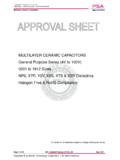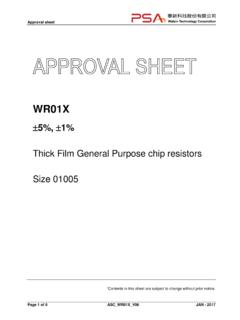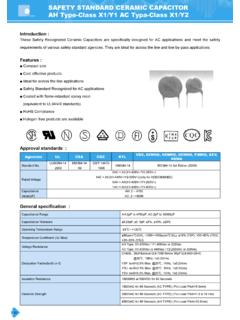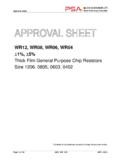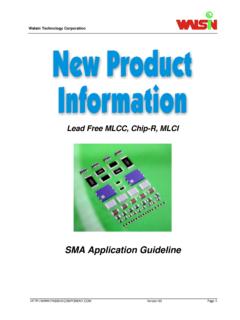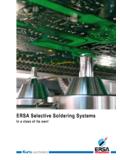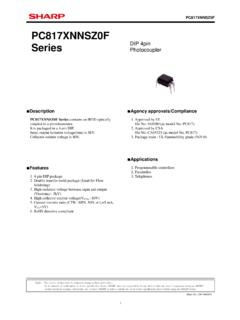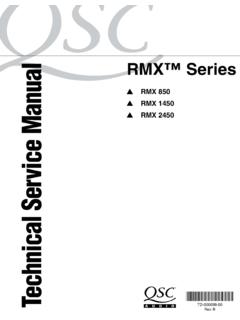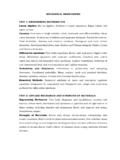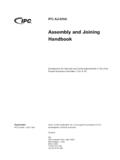Transcription of MLCC application guide 2017 Q2 - passive component
1 MLCC application guide Jun. 2017 1/11 MLCC application guide MLCC application guide Jun. 2017 2/11 No. Process Condition 1 Operating Condition (Storage) 1) The capacitor must be stored in an ambient temperature between 5 ~ 40 C with a relative humidity of 20 ~ 70%. The products should be used within 12 months upon receipt. 2) The capacitors must be operated and stored in an environment free of dew condensation and these gases such as Hydrogen Sulphide, Hydrogen Sulfate, Chlorine and Ammonia and sulfur.
2 3) Avoid storing in direct sunlight and falling of dew. 4) Do not use capacitors under high humidity and high and low atmospheric pressure which may affect capacitors reliability. 2 Circuit design ! Caution 2-1 Operating temperature Operating temperature should be followed strictly within this specification, especially be careful with maximum temperature. 1) Do not use capacitor above the maximum allowable operating temperature. 2) Surface temperature including self heating should be below maximum operating temperature.
3 (Due to dielectric loss, capacitor will heat itself when AC is applied. Especially at high frequencies around its SRF, the heat might be so extreme that it may damage itself or the surrounding area. Please design the circuit so that the maximum temperature of the capacitor including the self heating to be below the maximum allowable operating temperature. Temperature rise shall be below 20 C) 2-2 Operating voltage 1) Operating voltage across the terminals should be below the rated voltage. When AC and DC are super imposed, the peak must be below the rated voltage.
4 With AC or pulse overshooting, Vp-p must be below the rated voltage. --------------(1)&(2) AC or Pulse with overshooting, Vp-p must be below the rated voltage. ----------(3),(4)&(5) When the voltage is started to apply to the circuit or it is stopped applying, the irregular voltage may be generated for a transit period because of resonance or switching.
5 Be sure to use a capacitor within rated voltage containing these irregular voltage. 2) Even below the rated voltage, if repetitive high frequency AC or pulse is applied, the reliability of the capacitor may be reduced. 3) Voltage derating will greatly reduce the failure rate. Since the failure rate follows the 3 power law of voltage, the failure rate used under Uw with UR rated product will be lowered as (Uw/UR)3 . MLCC application guide Jun. 2017 3/11 No. Process Condition 3 Designing board The amount of solder at the terminations has a direct effect on the reliability of the capacitor.
6 1) The greater the amount of solder, the higher the stress on the chip capacitor, and the more likely that it will break. When designing a board, determine the shape and size of the solder pads to have proper amount of solder on the terminations. 2) Avoid using common solder pads for multiple terminations and provide individual solder pads for each terminations. See the following table for recommended pad dimensions. Reflow soldering Footprint dimensions in mm Processing remarks Placement Accuracy SIZE A B C D E F G 01005 N/A Reflow or hot plate soldering 0201 N/A 0402 0508 0505 N/A N/A N/A 0603 0612 0805 1111 N/A N/A N/A 1206 1210 1808 1825 N/A N/A N/A 1812
7 2211 N/A 2220 N/A 2225 N/A N/A N/A MLCC application guide Jun. 2017 4/11 No. Process Condition 3 Designing board (Continued) Wave soldering Footprint dimensions in mm Proposed number & Dimensions of dummy tracks Placement Accuracy SIZE A B C D E F G 0603 1x ( ) 0805 1x ( ) 1206 3x ( ) 1210 3x ( ) Footprint design for C Array : Type 0603*4 0402*4 A + B D P F 3) Layout recommendation Must be avoided MLCC application guide Jun.
8 2017 5/11 3 Designing board (Continued) 4) Mechanical stress varies according to location of chip capacitors on the board. 5) Recommended chip capacitor layout is as follows: MLCC application guide Jun. 2017 6/11 4 Mounting 4-1 Stress from mounting head If the mounting head is adjusted too low, it may induce excessive stress in the chip Capacitor resulting in cracking. Please take the following precautions. 1) Adjust the bottom dead center of the mounting head to just on the board surface and not pressing on it.
9 2) Adjust the mounting head pressure to be 1 to 3N of static weight. 3) To minimize the impact energy from mounting head, it is important to provide support from the bottom side of the board.(see following) When the centering jaw is worn out, it may give mechanical impact on the capacitor to cause a crack. Please control the close up dimension of the centering jaw and provide sufficient preventive maintenance and replacement of it. 4-2 Amount of adhesive Example : 0805(2012) and 1206(3216) Figure 0805/1206 case sizes as examples a min b 70 ~ 100 um c Do not touch the solder land MLCC application guide Jun.
10 2017 7/11 5 soldering 5-1 Flux selection Although highly-activated flux gives better solderability, substances which increase activity may also degrade the insulation of the chip capacitors. To avoid such degradation, the following is recommended. 1) It is recommended to use a mildly activated rosin flux (less than wt% chlorine). Strong flux is not recommended. 2) Excessive flux must be avoided. Please provide proper amount of flux. 3) When water-soluble flux is used, enough washing is necessary. 5-2 Recommended soldering profile by various methods 1) Recommended reflow soldering profile for SMT process with SnAgCu series solder paste 2) Wave soldering profile Recommended wave soldering profile for SMT process with SnAgCu series solder.
